Abstract
We investigated the antioxidant activity and neuroprotective effects of an enzymatic hydrolyzate from silkworms fed the leaves of Cudrania tricuspidata (ESLC) produced by enzymatic treatment. The proteins in silkworms fed the leaves of Cudrania tricuspidata (SLC) were effectively hydrolyzed using enzymatic treatment. The total polyphenols of ESLC were significantly higher, and the superoxide dismutase-like activity and 2,2′-azino-bis (3-thylbenzothiazoline-6-sulfonicacid) diammonium salt radical scavenging capacity of ESLC were significantly increased compared to the SLC group. We evaluated the properties of ESLC to protect SH-SY5Y cells from H2O2-induced oxidative stress. The viability rate of SH-SY5Y neuroblastoma cells was significantly restored when treated with ESLC at a concentration of 100 μg/mL or 250 μg/mL. Furthermore, the mitogen-activated protein kinase (MAPK) pathway was investigated, and ESLC significantly inhibited the phosphorylation of c-Jun N-terminal kinase (JNK), extracellular signal-regulated kinase (ERK), and p38. Therefore, ESLC can potentially be used as an antioxidant. The polyphenol content increases owing to hydrolysis through enzymatic treatment, which increases the antioxidant effect and inhibits the phosphorylation of JNK, ERK, and p38 by activating the MAPK pathway, which inhibits cell death from oxidative stress and exerts cytoprotective effects.
1. Introduction
Globally, population growth and expanding economic scales are increasing the demand for high-quality protein sources. The uncontrolled livestock population growth is causing environmental pollution and food shortages [1]. To address these issues, markets that provide alternatives to protein through meat consumption have been established, and the edible insect market is growing rapidly [2]. Insect resources are promising future agricultural resources as food, functional materials, and agricultural materials, and are emerging as new avenues for agriculture in rural areas with stagnant agricultural income levels [3]. In addition, they have high feed efficiency and are free from environmental pollution factors, such as conventional pesticides, livestock manure, and greenhouse gases, which can contribute to public value [4,5]. Lepidoptera, Coleoptera, Orthoptera, Isoptera, and Hymenoptera are the main types of insects utilized as edible insects [6]. Since people tend to be reluctant to consume insects because of their appearance, they are powdered and added to products to eliminate rejection [7].
In Korea, only Oxya chinensis sinuosa Mishchenko, Batryticatus Bombyx larvae, and Batryticatus Bombyx are listed as food ingredients that can be manufactured and sold. To revitalize the edible insect industry, seven additional insects have been registered as edible insects, Apis mellifera Linnaeus, Zophobas atratus, Gryllus bimaculatus, Allomyrina dichotoma larvae, Protaetia brevitarsis seulensis larvae, Tenebrio molitor Linnaeus larva, and Locusta migratoria migratoria Linnaeus [7]. These insects have excellent nutritional value, and their safety has been confirmed by analyzing harmful substances, such as pesticide residues, heavy metals, microbes, and mycotoxins [8]. Furthermore, their safety has been scientifically proven by showing no toxicity in repeated doses, single doses, and genotoxicity tests [9,10]. Animal studies that measured immunoglobulin E and histamine levels to analyze safety confirmed safety against allergies [11].
Among edible insects, the silkworm is a larva belonging to the family Bombycidae and has excellent nutritional value because of its very high protein content [12]. The silkworm has been used as a functional material in the food industry because it has been reported to have various functions such as hepatoprotective effects [13], blood sugar improvement effects [14], gut microbiota composition modulation [15], and antioxidant activity [16]. Mulberry leaves are rich in nutrients and contain high levels of various bioactive substances such as polyphenols and flavonoids [17,18]. The nutritional and functional components of mulberry leaves significantly affect silkworm growth and quality [19]. Cudrania tricuspidata belongs to the family Moraceae, and compared to ordinary mulberry leaves, the leaves are rich in functional components and bioactive substances such as gamma-aminobutyric acid, rutin, dihydroquercetin, and 1-deoxynojirimycin [20,21]. Particularly, it has been reported to have excellent antioxidant activity and neuroprotective effects owing to its high bioactive substance content, such as polyphenols and flavonoids [22,23].
Enzymes can hydrolyze proteins in a material into smaller molecules, such as peptides, which have various functionalities [24]. These components can be used as bioactive substances, and it has been reported that the antioxidant effects of hydrolyzates produced by enzymatic treatment increase with an increase in the degree of protein hydrolysis [25]. Hydrolysis by enzymatic treatment can increase the polyphenol and flavonoid contents in the material, thereby increasing its antioxidant activity [26]. In addition, Cermerio et al. [16] reported that the hydrolysis of silkworms by enzymatic treatment generates functional peptides that can reduce oxidative stress in cells and increase antioxidant activity, and that the antioxidant activity of silkworm-derived hydrolyzates can be altered by enzymatic treatment conditions. Therefore, we investigated the effects of hydrolysis by examining the antioxidant activity of hydrolyzates from silkworms fed the leaves of Cudrania tricuspidata (SLC). We also studied the protective effect of hydrolyzates and their mechanism on nerve cells from oxidative stress to determine their potential use as functional materials.
2. Materials and Methods
2.1. Enzymatic Preparation of Silkworm Hydrolyzate
SLC and steamed and lyophilized mature silkworm powder (SMSP), used in the experiment, were supplied by Nutricare Co., Ltd. (Seoul, Republic of Korea). Enzymatic hydrolyzates from silkworms fed the leaves of Cudrania tricuspidata (ESLC) were prepared by hydrolyzing SLC through an enzymatic treatment as follows. The SLC was ground with distilled water (DW) to a concentration of 20% w/w, and then hydrolyzed at 50 °C for 5 h with the addition of alcalase and bromelain at concentrations of 0.5% and 1.5%, respectively, after adjusting the pH to 7.0. The hydrolyzate was then adjusted to pH 5.5 and hydrolyzed at 50 °C for 2 h by adding viscozyme at 2.0%. The final hydrolyzate was enzymatically inactivated for 15 min at 100 °C and mixed with maltodextrin at a 6:4 ratio, and then spray-dried to produce ESLC. To further investigate the functional components and antioxidant effects of the samples, they were extracted with ethanol at 60 °C for 5 h, filtered, and condensed in a evaporator (R-100, Buchi, Flawil, Switzerland). The sample was lyophilized using an OPR FDT-8650 (Operon, Gyeonggi, Republic of Korea) and utilized for experiments.
2.2. Non-Protein Nitrogen (NPN)
The NPN measurements were carried out by diluting the sample 10-fold with DW. Then, an equal volume of 24% trichloroacetic acid (TCA) was added to the mixture, and the reaction was allowed to proceed for 30 min. The mixture was centrifuged at 4000 rpm for 20 min. The mixed solution was recovered and used for NPN analysis. Solution A was prepared by dissolving 2% sodium carbonate dissolved in 0.1 N sodium hydroxide, and solution B was prepared by mixing 0.5% copper sulfate in 1% sodium citrate. Solution A and solution B were mixed at a 50:1 ratio to prepare the alkaline copper reagent. Subsequently, 5 mL of the prepared reagent and 1 mL of the sample were mixed and incubated for 10 min at 25 °C; then, 0.5 mL of Folin’s reagent was added to induce a color reaction for 30 min. The absorbance was measured at 750 nm and values were calculated by converting to a standard curve using bovine serum albumin.
2.3. Determination of the Amino Acid Composition of Silkworm Hydrolyzate
The samples were diluted with DW and treated with a 10% solution of TCA. The protein was precipitated after centrifugation at 10,000 rpm for 12 min. Hexane was added to dissolve the fats and the precipitate obtained by centrifugation at 12,000 rpm was used as the sample. The samples were filtered through a 0.4 μm filter paper and measured using High-Performance Liquid Chromatography (Hitachi L-8900, Tokyo, Japan). The mobile phase was composed of solvent A, containing 140 mM of sodium acetate and 6% acetonitrile, and solvent B, containing 60% acetonitrile. The flow rate was constant at 1 mL/min, and the column temperature was maintained at 40 °C.
2.4. Determination of Flavonoid Concentration in Hydrolyzate from Silkworms
The total flavonoid content was measured using a modified version of the Davis method [27]. To analyze the flavonoid content, the sample was mixed with DW at a 1:4 ratio. Then, a 0.3 mL quantity of a 5% sodium nitrite solution was added and stirred for 5 min at 25 °C. Subsequently, a 1:3 ratio of a 10% aluminum chloride solution was added, and the reaction was stirred at 25 °C for 6 min. Then, 0.3 mL of a 10% aluminum chloride solution was added and stirred at 25 °C for 5 min, and 2 mL of a 1 M sodium hydroxide solution was mixed. The absorbance was measured at 510 nm using a spectrophotometer (Optizen 2120UV, Mecasys, Daejeon, Republic of Korea) after the addition of 2.4 mL of DW. A standard curve prepared with catechin hydrate was used to determine the total flavonoid content.
2.5. Determination of Polyphenol Concentration in Hydrolyzate from Silkworms
The method described by Singleton et al. [28] was used for the determination of total polyphenols. The samples were diluted 10-fold with DW. Then, 1 mL of a 1 M Folin–Ciocalteu phenol reagent was added and the mixture was incubated at 25 °C for 5 min. Subsequently, 10 mL of 7% sodium carbonate and 4 mL of DW were added, and the reaction mixture was incubated at 25 °C for 90 min. The absorbance was determined at 750 nm using an Optizen 2120UV spectrophotometer (Mecasys). The total polyphenol content was determined using a standard curve generated using gallic acid.
2.6. The 2,2-diphenyl-1-picrylhydrazyl (DPPH) Radical Scavenging
The DPPH radical scavenging activity was determined using a modified version of the method described by Piao et al. [29]. Briefly, 100 μL of the sample was added to 150 μL of 0.2 mM DPPH and the mixture was allowed to react at 37 °C for 30 min in a dark room. The absorbance was measured at 517 nm using a microplate reader (Tecan Multifunction, Männedorf, Switzerland). The positive control was ascorbic acid and the DPPH radical scavenging activity was estimated using the following equation:
DPPH radical scavenging activity (%) = [1 − (S/C)] × 100
Here, S is the absorbance of the sample; C is the absorbance of the blank.
2.7. 2,2′-Azino-bis(3-ethylbenzothiazoline-6-sulfonicacid) Diammonium Salt (ABTS) Radical Scavenging
The ABTS radical scavenging activity was determined by a modification of the method described by Re et al. [30]. Briefly, 2.6 mM potassium persulfate and 7.4 mM ABTS were mixed equally and allowed to form radicals in a darkroom for 24 h. Immediately prior to the experiment, the ABTS solution was diluted with phosphate-buffered saline (PBS) to an absorbance value of 0.70 ± 0.03 at 732 nm using an Optizen 2120UV (Mecasys). The sample was mixed with ABTS solution at a ratio of 1:19 and incubated in the dark for 10 min. Subsequently, the absorbance was measured at 732 nm using an Optizen 2120UV spectrophotometer (Mecasys). The positive control was ascorbic acid and the ABTS radical scavenging activity was estimated using the following equation:
ABTS radical scavenging activity (%) = [1 − (S/C)] × 100
Here, S is the absorbance of the sample; C is the absorbance of the blank.
2.8. Superoxide Dismutase (SOD)-Like Activity
The SOD-like activity was determined by measuring the amount of pyrogallol produced, which catalyzes the conversion of reactive oxygen species (ROS) to H2O2, by modifying the method of Marklund and Marklund [31]. Briefly, the sample was mixed with a solution of trizma hydrochloride (10 mM EDTA, 50 mM tris aminomethane, pH 8.9 and pyrogallol (7.2 mM) at 25 °C for 10 min. The reaction mixture comprised 10 μL of the sample, 150 μL of the trizma hydrochloride solution, and 10 μL of pyrogallol. Absorbance was measured at 420 nm using a Tecan Multifunction after stopping the reaction by adding 50 μL of 1 N HCl. The positive control was ascorbic acid and SOD-like activity was calculated using the following equation:
SOD activity (%) = [1 − (S/C)] × 100
S is the absorbance of the sample; C is the absorbance of the blank.
2.9. SH-SY5Y Cell Treatment and Cell Viability
The SH-SY5Y human neuroblastoma cells used in the experiments were obtained from the Korea Cell Line Bank (Seoul, Republic of Korea). The SH-SY5Y cells were cultured in MEM medium supplemented with 10% FBS and 1% penicillin/streptomycin and incubated at 37 °C in a 5% CO2 incubator. When the cells reached 70–80% confluence, they were washed with PBS (pH 7.4), treated with trypsin/ethylenediaminetetraacetic acid to detach the cells, centrifuged at 1000 rpm for 5 min to recover the cells, and then seeded and used for experiments. To investigate the cytotoxicity of ESLC in SH-SY5Y cells, cell viability was analysed using the 3-(4,5-dimethylthiazol-2-yl)-2,5-diphenyl-2-tetrazolium bromide (MTT) assay. The cells were seeded at a concentration of 6 × 104 cells per well in 96-well plates. After 24 h of adherence, they were treated with different concentrations of ESLC (5, 10, 25, 50, 100, and 250 μg/mL) and incubated for 18 h. Then, 200 μL of the MTT solution at 2.5 μg/mL was added and incubated for 3 h at 37 °C in a 5% CO2 incubator. After the incubation, the culture in each well was removed and 100 μL of dimethyl sulfoxide (DMSO) was added. Cell viability was determined by measuring the absorbance at 570 nm using a Tecan Multifunction (Tecan) and expressed as a percentage of the control absorbance.
2.10. Antioxidant Activity
The protective effect of ESLC on H2O2-induced oxidative stress in SH-SY5Y cells was investigated. The cells were seeded at a concentration of 6 × 104 cells per well in 96-well plates and incubated for 24 h. Then, ESLC was treated with different concentrations (5, 10, 25, 50, 100, 250 μg/mL) for 1 h. H2O2 was then added to each well at a concentration of 100 μM and incubated for 30 min. Each well was incubated with 200 μL of the MTT solution at a concentration of 2.5 μg/mL for 3 h at 37 °C and 5% CO2. After removing the culture, 100 μL of DMSO was added. The absorbance was measured at 570 nm using a Tecan Multifunction.
2.11. Western Blot
Cultures of ESLC-treated SH-SY5Y cells were removed, and the cells were washed twice with phosphate-buffered saline. The proteins were extracted from the harvested cells using an RIPA buffer (Thermo Fisher Scientific, Rockford, IL, USA) supplemented with a protease inhibitor (GenDEPOT, Barker, TX, USA). Protein concentrations were quantified using a BCA protein assay kit from Thermo Fisher Scientific and adjusted to the same concentration. Then, sodium dodecyl sulfate–polyacrylamide gel electrophoresis (SDS-PAGE) was performed on a 10% gel. The separated proteins were electrophoresed and transferred to polyvinylidene fluoride membranes (Millipore). The blots were blocked with TBS-T containing 5% (w/v) skim milk powder for 3 h at 25 °C. For protein expression analysis, the membranes were incubated with c-Jun N-terminal kinases (JNK; Cell signaling, #9252), extracellular signal-regulated kinase (ERK; Cell signaling, #4695), p38 (Cell signaling, #8690), p-JNK (Cell signaling, #4668), p-ERK (Cell signaling, #4370), p-p38 (Cell signaling, #4370), and β-actin (Santa cruz, #47778) primary antibody diluted at a 1:1000 ratio in 5% skim milk overnight at 4 °C. The following day, the membranes were washed three times with TBS-T and then incubated with the secondary antibody, anti-rabbit IgG, which was diluted in 5% skim milk at a 1:1000 ratio, for 1 h at 25 °C. After four washes with TBS-T, the membrane was developed using the Immobilon Western Chemiluminescent HRP substrate (Millipore, MA, USA) in the dark. The final band area was analyzed using the ImageJ software v.1.8.0 (National Institute of Health, Bethesda, MD, USA).
2.12. Statistical Analysis
Data are expressed as mean ± standard error (SEM). Significance of differences among groups was determined using SAS/PROC GLM software v.9.1 (SAS Institute Inc., Cary, NC, USA). Student’s t-test or a one-way analysis of variance (ANOVA) and Duncan’s multiple range test were used to analyze statistical significance.
3. Results
3.1. NPN
The NPN method measures the nitrogen compounds produced by protein degradation through hydrolysis, and the degree of protein hydrolysis by enzymatic treatment can be determined using NPN. ESLC showed significantly higher NPN levels than SLC (p < 0.05), confirming that SLC was effectively hydrolyzed by enzymatic treatment (Figure 1).
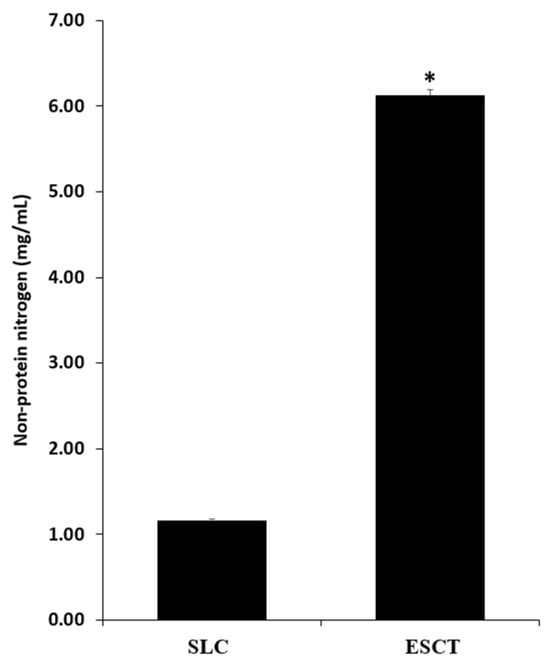
Figure 1.
Non-protein nitrogen analysis performed on SLCs and ESLC. The means ± SEM are presented as values. The data were analyzed using Student’s t-test (* p < 0.05). SLC, silkworms fed the leaves of Cudrania tricuspidata; ESLC, enzymatic hydrolyzate from silkworms fed the leaves of Cudrania tricuspidata.
3.2. Composition of Amino Acid
We analyzed the amino acid contents of SLC and ESLC to determine the amino acid changes caused by enzymatic treatment (Table 1). The amino acid compositions of SLC and ESLC did not demonstrate significant differences in essential or non-essential amino acids, confirming that the enzyme treatment did not affect the amino acid composition of SLC.

Table 1.
The amino acid composition of SLC and ESLC.
3.3. Total Flavonoid and Polyphenol Contents
The flavonoid and polyphenol contents of SLC, ESLC, and SMSP extracts were analyzed (Figure 2). The flavonoid contents of SLC and ESLC were 6.58 ± 0.28 mg CA/g and 6.87 ± 0.15 mg CA/g, respectively, which were significantly higher than the flavonoid content of SMSP, which was 1.96 ± 0.03 mg CA/g (p < 0.05). The total polyphenol content was significantly highest in ESLC, with 110.12 ± 1.20 mg GAE/g (p < 0.05), followed by SLC with 42.02 ± 0.26 mg GAE/g and SMSP with 27.08 ± 0.40 mg GAE/g.
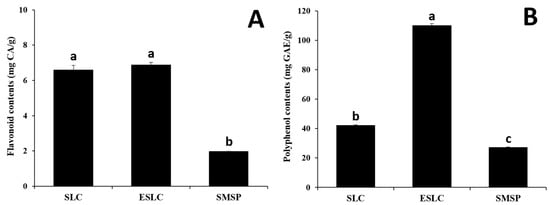
Figure 2.
Total flavonoid and polyphenol contents in SLC, ESLC, and SMSP extracts. (A) Flavonoid content; (B) polyphenol content. Values are means ± SEM. Different letters (a–c) above the bars indicate significant differences according to one-way ANOVA with Duncan’s multiple range test at p < 0.05. SLC, silkworms fed the leaves of Cudrania tricuspidata; ESLC, enzymatic hydrolyzate from silkworms fed the leaves of Cudrania tricuspidata; SMSP, steamed and lyophilized mature silkworm powder.
3.4. DPPH Radical Scavenging Activity
As shown in Figure 3, among the tested compounds, ascorbic acid exhibited the highest DPPH radical scavenging activity (89.60%) (p < 0.05). SLC and ESLC also showed significantly (p < 0.05) higher DPPH radical scavenging activities (76.06% and 71.36%, respectively) than SMSP, except for ascorbic acid, which was used as a positive control.
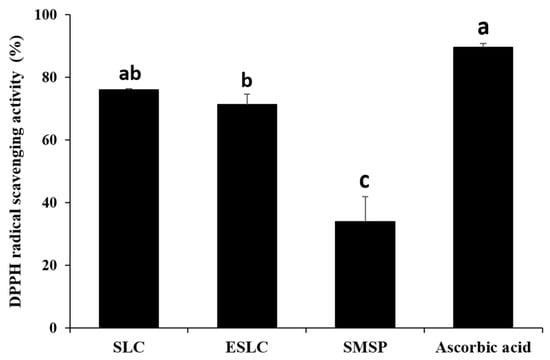
Figure 3.
DPPH radical scavenging activity in SLC, ESLC, and SMSP extracts. Values are means ± SEM. Significant differences (p < 0.05) were observed among the groups, as indicated by the different letters (a–c) above the bars in the one-way ANOVA with Duncan’s multiple range test. SLC, silkworms fed the leaves of Cudrania tricuspidata; ESLC, enzymatic hydrolyzate from silkworms fed the leaves of Cudrania tricuspidata; SMSP, steamed and lyophilized mature silkworm powder.
3.5. ABTS Radical Scavenging Activity
Figure 4 shows the ABTS radical scavenging activity of each material. Excluding the positive control, the ABTS radical scavenging activity of the ESLC extract was the highest (78.53%), while that of the SMSP extract was the lowest (6.97%) (p < 0.01), among SLC, ESLC, and SMSP.
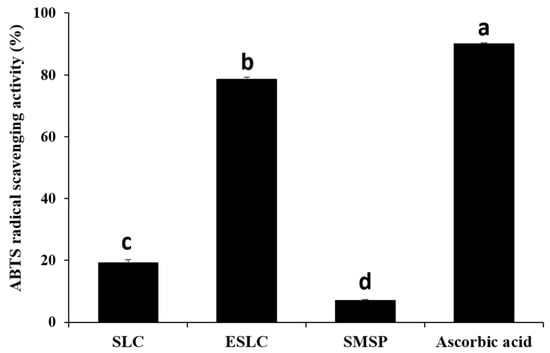
Figure 4.
ABTS radical scavenging activity in SLC, ESLC, and SMSP extracts. Values are means ± SEM. Significant differences (p < 0.01) were observed among the groups, as indicated by the different letters (a–d) above the bars in the one-way ANOVA with Duncan’s multiple range test. SLC, silkworms fed the leaves of Cudrania tricuspidata; ESLC, enzymatic hydrolyzate from silkworms fed the leaves of Cudrania tricuspidata; SMSP, steamed and lyophilized mature silkworm powder.
3.6. SOD-like Activity
Figure 5 shows that ascorbic acid had the highest SOD-like activity (86.63%) (p < 0.01). The ESLC extract exhibited significantly higher SOD-like activity (84.18%; p < 0.05) compared to the SLC and SMSP extracts, with the exception of ascorbic acid, which was used as the positive control.
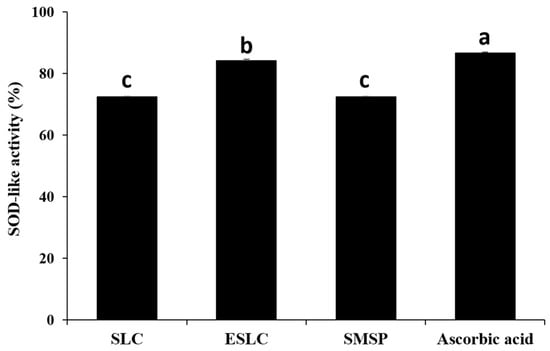
Figure 5.
SOD-like activity in SLC, ESLC, and SMSP extracts. Values are means ± SEM. Significant differences (p < 0.01) were observed among the groups, as indicated by the different letters (a–c) above the bars in the one-way ANOVA with Duncan’s multiple range test. SLC, silkworm-fed Cudrania tricuspidata leaves; ESLC, enzymatic hydrolyzate from silkworms fed the leaves of Cudrania tricuspidata; SMSP, steamed and lyophilized mature silkworm powder.
3.7. Neuroprotective Effect of ESLC on H2O2-Induced Oxidative Stress in SH-SY5Y Cells
To assess the cytotoxicity of ESLC on SH-SY5Y cells, we measured cell viability using the MTT assay after treating the cells with different concentrations of ESLC (0–250 μg/mL) for 18 h. No statistically significant differences in cell viability were observed at any concentration, indicating the absence of cytotoxicity. SH-SY5Y neuroblastoma cells were treated with H2O2 to induce oxidative stress, and the effect of ESLC on reducing oxidative stress was investigated. As shown in Figure 6A, the viability of SH-SY5Y cells without ESLC treatment was 64.68%, but when ESLC was added at concentrations of 100 μg/mL and 250 μg/mL, the viability of SH-SY5Y cells was significantly increased to 75.10% and 76.91%, respectively (p < 0.05). Moreover, we analyzed the effect of ESLC on cell viability restoration after inducing damage by treating SH-SY5Y cells with H2O2. Compared to the control group without ESLC treatment, the viability of SH-SY5Y cells significantly increased to 74.71% and 75.93% when treated with ESLC at concentrations of 100 μg/mL and 250 μg/mL, respectively (p < 0.05) (Figure 6B).
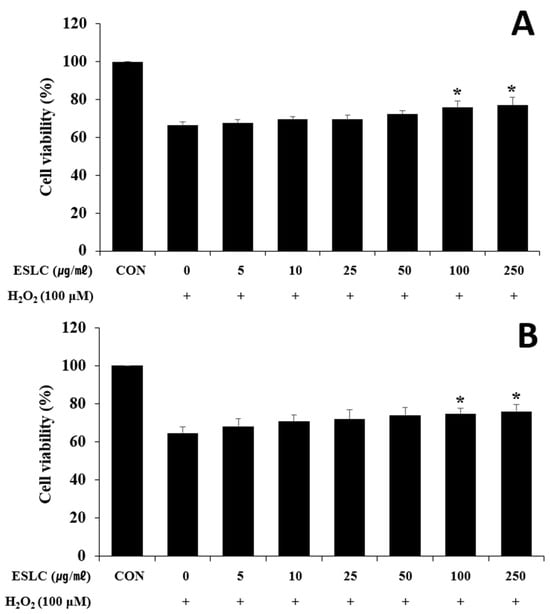
Figure 6.
Effect of ESLC on the viability of SH-SY5Y cells impaired by H2O2 treatment. (A) SH-SY5Y cells were pretreated with different concentrations of ESLC for 1 h, followed by treatment with 100 μM H2O2 for 30 min. (B) SH-SY5Y cells were treated with 100 μM H2O2 for 30 min, and then the medium was replaced, and different ESLC concentrations were treated for 18 h. The means ± SEM are presented as values. The data were analyzed using Student’s t-test (* p < 0.05). CON, control; ESLC, enzymatic hydrolyzate from silkworms fed the leaves of Cudrania tricuspidata.
3.8. The Impact of ESLC on the ERK, JNK, and p38 Pathways in SH-SY5Y Cells Stimulated with H2O2
The MAPK pathway plays a crucial role in cell differentiation, growth, and apoptosis in response to external stimuli. It is activated by oxidative stress and serves as an apoptosis signaling system. To investigate the inhibitory effects of ESLC on oxidative stress in SH-SY5Y cells, we induced oxidative stress by treating the cells with ESLC for 1 h, followed by treatment with H2O2 for 30 min. The phosphorylation of ERK, JNK, and p38 MAPK signaling pathways was examined by Western blotting. The phosphorylation levels of the ERK, JNK, and p38 MAPK signaling pathways increased in the absence of ESLC. However, in a concentration-dependent manner, the phosphorylation levels of ERK, JNK, and p38 significantly decreased (p < 0.05) (Figure 7). Compared with the absence of ESLC, ERK phosphorylation levels decreased when treated with ESLC at concentrations above 50 μg/mL, JNK phosphorylation levels decreased when treated with ESLC at concentrations above 25 μg/mL, and p38 phosphorylation levels decreased when treated with ESLC at concentrations above 250 μg/mL.
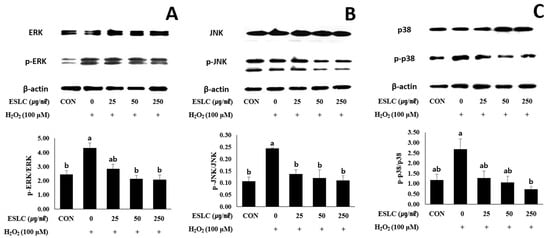
Figure 7.
Effect of ESLC on MAPK signaling pathway in SH-SY5Y cells impaired by H2O2 treatment. (A) p-ERK/ERK; (B) p-JNK/JNK; (C) p-p38/p38. Values are means ± SEM. Significant differences (p < 0.01) were observed among the groups, as indicated by the different letters (a,b) above the bars in the one-way ANOVA with Duncan’s multiple range test. CON, control; ESLC, enzymatic hydrolyzate from silkworms fed the leaves of Cudrania tricuspidata. ERK, extracellular signal-regulated kinase; JNK, c-Jun N-terminal kinase; p-ERK, phospho-extracellular signal-regulated kinase; p-JNK, phospho-c-Jun N-terminal kinase; p-p38, phospho-p38.
4. Discussion
In this study we hydrolyzed SLC to produce ESLC using commercial enzymes alkalase, bromelain, and viscozyme. We measured the NPN content, which is a nitrogenous compound produced by protein degradation due to hydrolysis, and observed that the NPN content of ESLC was remarkably increased by enzyme treatment. In addition, the SLC and ESLC amino acid composition were analyzed to determine the amino acid changes induced by enzymatic treatment. The SLC and ESLC amino acid composition were not significantly different, indicating that enzymatic treatment effectively hydrolyzed the proteins in SLC without affecting the amino acid composition.
Polyphenolic compounds are aromatic compounds with hydroxyl groups that are observed in large amounts in leafy vegetables and fruits [32]. The hydroxyl groups of polyphenols can easily combine with various compounds and exhibit antioxidant activity, which inhibits oxidation by donating hydrogen to alkyl radicals or alkyl peroxy radicals to scavenge radicals [33]. The increase in bioactive substance content due to enzymatic treatment is because compounds bound to polymeric substances, such as polysaccharides and proteins, are degraded and converted into small-molecule phenolic compounds during enzymatic treatment. In addition, Arranz and Calixto [34] reported that the polyphenol content of extracts might increase as polyphenolic compounds bound to polysaccharides and proteins are released by enzymatic treatment [35]. The polyphenol content of ESLC extracts developed using enzymatic treatment was remarkably higher than that of SLC (p < 0.05). This was similar to the findings of Choi et al. [21], who reported that the hydrolysis of silkworm powder by enzymatic treatment increased the total polyphenol content.
The SOD-like activity and ABTS radical scavenging capacity are commonly used to investigate the antioxidant effects of functional materials. The antioxidant activity of ESLC was highest against the ABTS radical, while there was no significant difference in efficacy against the DPPH radical. The difference is that ABTS radical scavenging activity can be determined for both polar and non-polar samples, whereas DPPH can only be determined for non-polar materials. In addition, DPPH tests with free radicals whereas ABTS tests with cationic radicals, and the nature of the substrates is different, so the ABTS test may have a wider range of applications than the DPPH test. The ABTS radical scavenging capacity can be analyzed to measure the oxidative capacity of the extract because the antioxidants in the sample react with the ABTS radicals generated by the reaction of the ABTS solution with potassium persulfate. The blue-green color of the radicals is decolorized, indicating a change in absorbance [36]. SOD is an enzyme involved in the scavenging of superoxide formed in the body and converts ROS formed by rancidity into H2O2, which is converted into harmless water and oxygen molecules to protect cells from ROS [37]. Polyphenol content and antioxidants are positively correlated, and that polyphenol extracts can effectively increase SOD activity by reducing oxidative stress in cells [33,38]. Furthermore, enzymatic hydrolysis increased the polyphenol content of the sample and enhanced its antioxidant effects [26]. Considering these studies, the significant increase in SOD-like activity and the ABTS radical scavenging capacity of ESLC in this study, in comparison to the other groups, is speculated to be due to an increase in polyphenol content by enzymatic treatment. Peptides are intermediates in the breakdown of proteins into amino acids, and enzymatic processing can generate various bioactive peptides that are present in foods [39] and have been reported to have various bioactive activities, including antioxidant activity [40,41]. The peptides produced by enzymatic treatment in this study may be associated with the increased antioxidant effects of ESLC.
Organisms obtain the energy needed to sustain life through cellular respiration, and some oxygen is converted into ROS, which damage the cells in the body [42]. ROS include hydroxyl radicals, superoxide, singlet oxygen, and H2O2, which are constantly produced in the body by physical or environmental factors but are mostly removed by the body’s antioxidant defense system [43]. However, ROS are highly unstable and reactive, and when overproduced, they can cause oxidative stress and damage the cells. Therefore, research is being conducted to identify antioxidants that can scavenge ROS [44,45]. ROS accumulation activates a cascade of mechanisms that disrupt cellular homeostasis and lead to cellular destruction, and ROS-induced oxidative stress is associated with neuronal cell death [46]. In this study, treatment with ESLC at concentrations of 100–250 μg/mL protected SH-SY5Y cells from H2O2-induced oxidative stress and significantly restored cell viability (p < 0.05). However, it is limited in that it did not compare the antioxidant activity of SLC and ESLC samples at the highest concentrations of 100 or 250 µg/mL. Cho and Lee [47] reported that the hydrolyzate produced by enzymatic hydrolysis increased cell viability in a dose-dependent manner, elevated Nrf2 expression (an antioxidant-related gene), and exerted antioxidant effects by reducing ROS levels during H2O2-induced oxidative stress in AML12 mouse hepatocytes. Moreover, enzymatic hydrolyzates and peptides produced from silkworm proteins have been reported to protect cells from oxidative stress, either by reacting directly with ROS or indirectly affecting antioxidant systems [48], which is similar to our results.
MAPK signaling pathways play important roles in metabolism, stress responses, cell proliferation, apoptosis, and the immune defense system [49,50]. To investigate the effect of ESLC on the protein expression of MAPK enzymes, such as JNK, p38, and ERK, we identified relevant factors by Western blotting and observed that ESLC treatment remarkably decreased the phosphorylation of JNK, ERK, and p38 in SH-SY5Y cells (p < 0.05) in a concentration-dependent manner. These results were similar to those of Tian et al. [51], who reported that an ethanol extract of Maclura tricuspidata fruit decreased the levels of JNK, p38, and ERK MAPK phosphorylation by H2O2. Therefore, ESLC may inhibit apoptosis and exert cytoprotective effects against oxidative stress by inhibiting phosphorylation via MAPK pathway activation. ESLC may inhibit JNK kinase, p38, and ERK phosphorylation by activating the MAPK pathway, thereby inhibiting apoptosis and exerting cytoprotective effects against oxidative stress. However, there are limitations in that the antioxidant effect and safety of ESLC were not confirmed at higher concentrations than those used in this study, and an analysis of genes associated with the antioxidant effect was not performed.
5. Conclusions
In conclusion, SLC proteins were effectively hydrolyzed by enzymatic treatment, and the total polyphenol content of ESLC was significantly increased, resulting in a significant increase in SOD-like and ABTS radical scavenging activities. We also confirmed the protective effect of ESLC on SH-SY5Y cells against oxidative stress induced by H2O2. If further studies, including the determination of optimal ESLC concentrations and gene associations with antioxidant effects, were conducted sequentially, the value of ESLC as a natural functional material with excellent antioxidant effects would be high.
Author Contributions
Conceptualization, K.-S.H.; methodology, G.-M.A., T.-H.J. and K.-S.H.; validation, G.-M.A. and T.-H.J.; formal analysis, G.-M.A. and T.-H.J.; investigation, G.-M.A.; data curation, T.-H.J.; writing—original draft preparation, G.-M.A. and T.-H.J.; writing—review and editing, K.-S.H.; supervision, K.-S.H.; project administration, K.-S.H.; funding acquisition, K.-S.H. All authors have read and agreed to the published version of the manuscript.
Funding
This work was supported by a grant from the Agricultural Technology Commercialization Support Project through the Rural Development Administration, Republic of Korea (project number: RS-2022-KO000997).
Institutional Review Board Statement
Not applicable.
Informed Consent Statement
Not applicable.
Data Availability Statement
The data generated for this study are available upon reasonable request from the corresponding author. The data are not publicly available due to privacy.
Acknowledgments
We thank the researchers who assisted in the experiments.
Conflicts of Interest
The authors declare no conflicts of interest.
References
- Alston, J.M.; Beddow, J.M.; Pardey, P.G. Agricultural research, productivity, and food prices in the long run. Science 2009, 325, 1209–1210. [Google Scholar] [CrossRef]
- Song, M.H.; Han, M.H.; Lee, S.H.; Kim, E.S.; Park, K.H.; Kim, W.T.; Choi, J.Y. A field survey on edible insect farms in Korea. J. Life Sci. 2017, 27, 702–707. [Google Scholar] [CrossRef]
- van Huis, A. Potential of insects as food and feed in assuring food security. Annu. Rev. Entomol. 2013, 58, 563–583. [Google Scholar] [CrossRef]
- Nakagaki, B.J.; Defoliart, G.R. Comparison of diets for mass-rearing acheta domesticus (Orthoptera, Gryllidae) as a novelty food, and comparison of food conversion efficiency with values reported for livestock. J. Econ. Entomol. 1991, 84, 84891–84896. [Google Scholar] [CrossRef]
- Oonincx, D.G.; van Itterbeeck, J.; Heetkamp, M.J.W.; van den Brand, H.; van Loon, J.J.A.; van Huis, A. An exploration on greenhouse gas and ammonia production by insect species suitable for animal or human consumption. PLoS ONE 2010, 5, e14445. [Google Scholar] [CrossRef]
- Yoo, J.M.; Hwang, J.S.; Goo, T.W.; Yun, E.Y. Comparative analysis of nutritional and harmful components in Korean and Chinese mealworms (Tenebrio molitor). J. Korean Soc. Food Sci. Nutr. 2013, 42, 249–254. [Google Scholar] [CrossRef]
- Hwang, D.S.; Lim, C.H.; Lee, S.H.; Yun, E.Y. Activation plan for the edible insect industry by improving perception. Food Sci. Nutr. 2022, 55, 128–139. [Google Scholar] [CrossRef]
- Baek, M.; Hwang, J.S.; Kim, M.A.; Kim, S.H.; Goo, T.W.; Yun, E.Y. Comparative analysis of nutritional components of edible insects registered as novel foods. J. Life Sci. 2017, 27, 334–338. [Google Scholar] [CrossRef]
- Noh, J.H.; Yun, E.Y.; Park, H.; Jung, K.J.; Hwang, J.S.; Jeong, E.J.; Moon, K.S. Subchronic oral dose toxicity of freeze-dried power of Allomyrina dichotoma larvae. Toxicol. Res. 2015, 31, 69–75. [Google Scholar] [CrossRef] [PubMed]
- Han, S.R.; Lee, B.S.; Jung, K.J.; Yu, H.J.; Yun, E.Y.; Hwang, J.S.; Moon, K.S. Safety assessment of freeze-dried powdered Tenebrio molitor larvae (yellow mealworm) as novel food source: Evaluation of 90-day toxicity in Sprague-Dawley rats. Regul. Toxicol. Pharmacol. 2016, 77, 206–212. [Google Scholar] [CrossRef] [PubMed]
- Noh, J.H.; Jeong, J.S.; Park, S.J.; Yun, E.Y.; Hwang, J.S.; Kim, J.S.; Jung, K.J.; Park, H.J.; Son, H.Y.; Moon, K.S. Toxicological safety evaluation of freeze-dried Protaetia brevitarsis larva powder. Toxicol. Rep. 2018, 5, 695–703. [Google Scholar] [CrossRef]
- Banday, M.T.; Adil, S.; Sheikh, I.U.; Hamadani, H.; Qadri, F.I.; Sahfi, M.E.; Sait, H.S.A.W.; Abd El-Mageed, T.A.; Salem, H.M.; Taha, A.E.; et al. The use of silkworm pupae (Bombyx mori) meal as an alternative protein source for poultry. Worlds Poult. Sci. J. 2023, 79, 119–134. [Google Scholar] [CrossRef]
- Ji, S.D.; Shin, K.H.; Ahn, D.K.; Cho, S.Y. The mass production technology and pharmaceutical effect of silkworm cordyceps (peacilomyces tenuipes). Food Sci. Ind. 2003, 36, 38–48. [Google Scholar]
- Yoon, J.W.; Rhee, S.K.; Lee, K.B. Effects of silkworm extract powder on plasma lipids and glucose in rats. J. Korean Soc. Food Sci. Nutr. 2005, 18, 140–145. [Google Scholar]
- Hu, Y.; Shi, Q.; Ying, S.; Zhu, D.; Chen, H.; Yang, X.; Xu, J.; Xu, F.; Tao, F.; Xu, B. Effects of compound Caoshi silkworm granules on stable COPD patients and their relationship with gut microbiota. A randomized controlled trial. Medicine 2020, 99, e20511. [Google Scholar] [CrossRef]
- Cermeno, M.; Bascon, C.; Amigo-Benavent, M.; Felix, M.; FitzGerald, R.J. Identification of peptides from edible silkworm pupae (Bombyx mori) protein hydrolyzates with antioxidant activity. J. Funct. Foods 2022, 92, 105052. [Google Scholar] [CrossRef]
- Lee, Y.S.; Rho, J.O. A study on quality characteristics of Kimchi with added mulberry leaves extracts. J. East. Asian Soc. Diet. Life 2014, 24, 827–836. [Google Scholar] [CrossRef]
- Son, H.K.; Han, J.H.; Lee, J.J. Anti-diabetic effect of the mixture of mulberry leaf and green tea powder in rats with streptozotocin-induced diabetes. Korean J. Food Preser. 2014, 21, 549–559. [Google Scholar] [CrossRef][Green Version]
- Yamamoto, K.; Yamada, N.; Endo, S.; Kurogi, K.; Sakakibara, Y.; Suiko, M. Novel silkworm (Bombyx mori) sulfotransferase swSULT ST3 is involved in metabolism of polyphenols from mulberry leaves. PLoS ONE 2022, 17, e0270804. [Google Scholar] [CrossRef] [PubMed]
- Lee, H.J.; Do, J.R.; Kwon, J.H.; Kim, H.K. Physiological activities of extracts from different parts of Cudrania Tricuspidata. J. Korean Soc. Food Sci. Nutr. 2011, 40, 942–948. [Google Scholar] [CrossRef]
- Choi, J.H.; Nam, M.J.; Ryu, G.H.; Jeon, J.W.; Yun, S.S. Quantitative analysis of chemical components of hydrolyzate from silkworm fed with Cudrania tricuspidata Leaves. Biomed. Sci. Lett. 2022, 28, 322–326. [Google Scholar] [CrossRef]
- Byun, E.B.; Jang, B.S.; Sung, N.Y.; Byun, E.H. Immunomodulatory activity of crude polysaccharide separated from Cudrania tricuspidata leaf. J. Korean Soc. Food Sci. Nutr. 2016, 45, 1099–1106. [Google Scholar] [CrossRef]
- Kim, Y.E.; Cho, E.J.; Byun, E.H. Antioxidant and neuroprotective effects of crude polysaccharide fractions from Cudrania tricuspidata fruits. Korean J. Food Sci. Technol. 2018, 50, 543–548. [Google Scholar] [CrossRef]
- Azm, N.A.E.; Fleita, D.; Rifaat, D.; Mpingirika, E.Z.; Amleh, A.; El-Sayed, M.M.H. Production of bioactive compounds from the sulfated polysaccharides extracts of ulva lactuca: Post-extraction enzymatic hydrolysis followed by ion-exchange chromatographic fractionation. Molecules 2019, 24, 2132. [Google Scholar] [CrossRef]
- You, L.; Zhao, M.; Cui, C.; Zhao, H.; Yang, B. Effect of degree of hydrolysis on the antioxidant activity of loach (Misgurnus anguillicaudatus) protein hydrolyzates. Innov. Food Sci. Emerg. Technol. 2009, 10, 235–240. [Google Scholar] [CrossRef]
- Cho, D.H.; Kim, M.J.; Sim, E.Y.; Jeon, Y.H.; Lee, C.K.; Woo, K.S. Effect of carbohydrase treatments on phenolics content and antioxidant activity of maize flour. Korean J. Food Sci. Technol. 2018, 50, 132–137. [Google Scholar] [CrossRef]
- Davis, W.B. Determination of flavanones in citrus fruits. Anal. Chem. 1947, 19, 476–478. [Google Scholar] [CrossRef]
- Singleton, V.L.; Orthofer, R.; Lamuela-Raventos, R.M. Analysis of total phenols and other oxidation substrates and antioxidants by means of Folin-Ciocalteu reagent. Methods Enzymol. 1999, 299, 152–178. [Google Scholar] [CrossRef]
- Piao, X.M.; Jang, E.K.; Chung, J.W.; Lee, G.A.; Lee, H.S.; Sung, J.S.; Jeon, Y.A.; Lee, J.R.; Kim, Y.G.; Lee, S.Y. Variation in antioxidant activity and polyphenol content in tomato stems and leaves. Plant Breed. Biotech. 2013, 1, 366–373. [Google Scholar] [CrossRef]
- Re, R.; Pellegrini, N.; Proteggente, A.; Pannala, A.; Yang, M.; Rice-Evans, C. Antioxidant activity applying an improved ABTS radical cation decolorization assay. Free Radic. Biol. Med. 1999, 26, 1231–1237. [Google Scholar] [CrossRef]
- Marklund, S.; Marklund, G. Involvement of the superoxide anion radical in the autoxidation of pyrogallol and convenient assay for superoxide dismutase. Eur. J. Biochem. 1974, 47, 469–474. [Google Scholar] [CrossRef]
- Lee, P.H.; Park, S.Y.; Jang, T.H.; Yim, S.H.; Nam, S.H.; In, M.J.; Kim, D.C.; Chae, H.J. Effects of complex carbohydrase treatment on physiological activities of pear peel and core. J. Korean Soc. Food Sci. Nutr. 2014, 43, 404–410. [Google Scholar] [CrossRef]
- Kim, E.J.; Chol, J.Y.; Yu, M.; Kim, M.Y.; Lee, S.; Lee, B.H. Total polyphenols, total flavonoid contents, and antioxidant activity of Korean natural and medicinal plants. Korean J. Food Sci. Technol. 2012, 44, 337–342. [Google Scholar] [CrossRef]
- Arranz, S.; Calixto, F.S. Analysis of polyphenols in cereals may be improved performing acidic hydrolysis: A study in wheat flour and wheat bran and cereals of the diet. J. Cereal Sci. 2010, 51, 313–318. [Google Scholar] [CrossRef]
- Hwang, I.G.; Woo, K.S.; Kim, T.M.; Kim, D.J.; Yang, M.H.; Jeong, H.S. Change of physicochemical characteristics of Korean pear (Pyrus pyrifolia Nakai) juice with heat treatment conditions. Korean J. Food Sci. Technol. 2006, 38, 342–347. [Google Scholar]
- Sung, H.M.; Kim, S.H.; Kim, K.M.; Yun, S.K.; Jung, H.J.; Kim, T.Y.; Wee, J.H. Antioxidant activity of soy-sprout extracts prepared by enzyme and ultra-high pressure. J. Korean Soc. Food Sci. Nutr. 2014, 43, 1228–1235. [Google Scholar] [CrossRef]
- Jeong, H.J.; Park, S.B.; Kim, S.; Kim, H.K. Total polyphenol content and antioxidative activity of wild grape (Vitiscoignetiae) extracts depending on ethanol concentrations. J. Korean Soc. Food Sci. Nutr. 2007, 36, 1491–1496. [Google Scholar] [CrossRef]
- Jung, H.N.; Lee, K.U.; Hwang, K.T.; Kwak, H.K. Antioxidant properties of polyphenol fractions from cranberry powder in LPS-stimulated RAW264.7 cells. J. Korean Soc. Food Sci. Nutr. 2015, 44, 1241–1247. [Google Scholar] [CrossRef]
- Park, B.Y.; Yoon, K.Y. Conditions for hydrolysis of perilla seed meal protein for producing hydrolyzates and ultrafiltered peptides and their antioxidant activity. Korean J. Food Preserv. 2018, 25, 605–612. [Google Scholar] [CrossRef]
- Jang, H.R.; Liceaga, A.M.; Yoon, K.Y. Purification, characterisation and stability of an antioxidant peptide derived from sandfish (Arctoscopus japonicus) protein hydrolyzates. J. Funct. Foods 2016, 20, 433–442. [Google Scholar] [CrossRef]
- Liu, M.; Wang, Y.; Liu, Y.; Ruan, R. Bioactive peptides derived from traditional Chinese medicine and traditional Chinese food: A review. Food Res. Int. 2016, 89, 63–73. [Google Scholar] [CrossRef] [PubMed]
- Balaban, R.S.; Nemoto, S.; Finkel, T. Mitochondria, oxidants, and aging. Cell 2005, 120, 483–495. [Google Scholar] [CrossRef] [PubMed]
- Valko, M.; Leibfritz, D.; Moncol, J.; Cronin, M.T.D.; Mazur, M.; Telser, J. Free radicals and antioxidants in normal physiological functions and human disease. Int. J. Biochem. Cell Biol. 2007, 39, 44–84. [Google Scholar] [CrossRef] [PubMed]
- Dumanovic, J.; Nepovimova, E.; Natic, M.; Kuca, K.; Jacevic, V. The significance of reactive oxygen species and antioxidant defense system in plants: A concise overview. Front. Plant Sci. 2021, 11, 552969. [Google Scholar] [CrossRef] [PubMed]
- Hasanuzzaman, M.; Raihan, R.H.; Masud, A.A.C.; Rahman, K.; Nowroz, F.; Rahman, M.; Nahar, K.; Fujita, M. Regulation of reactive oxygen species and antioxidant defense in plants under salinity. Int. J. Mol. Sci. 2021, 22, 9326. [Google Scholar] [CrossRef]
- Choi, S.Y.; Kim, J.H.; Lee, J.M.; Lee, S.H.; Cho, E.J. Protective effect of Acer okamotoanum from oxidative stress in C6 glial cells. J. Appl. Biol. Chem. 2017, 60, 141–147. [Google Scholar] [CrossRef]
- Cho, H.R.; Lee, S.O. Novel hepatoprotective peptides derived from protein hydrolyzates of mealworm (Tenebrio molitor). Food Res. Int. 2020, 133, 109194. [Google Scholar] [CrossRef] [PubMed]
- Xia, L.; Ng, T.B.; Fang, E.F.; Wong, J.H. Bioactive Constituents of the Silk Worm Bombyx mori. Antitumor Potential and Other Emerging Medicinal Properties of Natural Compounds; Springer: Berlin/Heidelberg, Germany, 2013; pp. 335–344. [Google Scholar] [CrossRef]
- Wada, T.; Penninge, J.M. Mitogen-activated protein kinases in apoptosis regulation. Oncogene 2004, 23, 2838–2849. [Google Scholar] [CrossRef]
- Soares, S.M.; Diniz, F.F.; Gomes, G.N.; Bahia, D. The mitogen-activated protein kinase (MAPK) pathway: Role in immune evasion by trypanosomatids. Front. Microbiol. 2016, 7, 183. [Google Scholar] [CrossRef]
- Tian, W.; Heo, S.; Kim, D.W.; Kim, I.S.; Ahn, D.C.; Tae, H.J.; Kim, M.K.; Park, B.Y. Ethanol extract of Maclura tricuspidata fruit protects SH-SY5Y neuroblastoma cells against H2O2-induced oxidative damage via inhibiting MAPK and NF-κB signaling. Int. J. Mol. Sci. 2021, 22, 6946. [Google Scholar] [CrossRef]
Disclaimer/Publisher’s Note: The statements, opinions and data contained in all publications are solely those of the individual author(s) and contributor(s) and not of MDPI and/or the editor(s). MDPI and/or the editor(s) disclaim responsibility for any injury to people or property resulting from any ideas, methods, instructions or products referred to in the content. |
© 2024 by the authors. Licensee MDPI, Basel, Switzerland. This article is an open access article distributed under the terms and conditions of the Creative Commons Attribution (CC BY) license (https://creativecommons.org/licenses/by/4.0/).